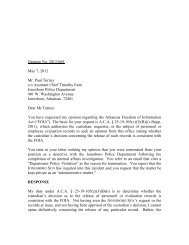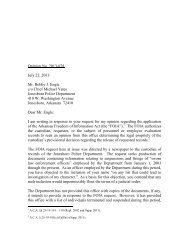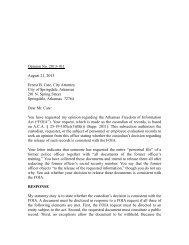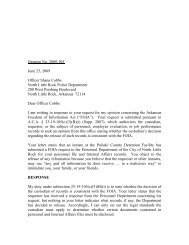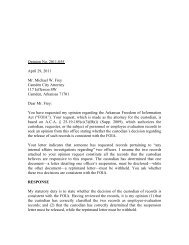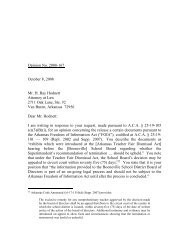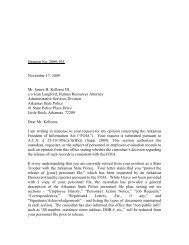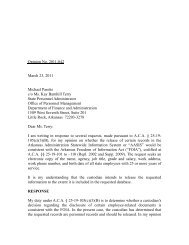Opinion No. 2010-038 April 1, 2010 Mr. Roy C. Lewellen Marianna ...
Opinion No. 2010-038 April 1, 2010 Mr. Roy C. Lewellen Marianna ...
Opinion No. 2010-038 April 1, 2010 Mr. Roy C. Lewellen Marianna ...
Create successful ePaper yourself
Turn your PDF publications into a flip-book with our unique Google optimized e-Paper software.
<strong>Mr</strong>. <strong>Roy</strong> C. <strong>Lewellen</strong><br />
<strong>Marianna</strong> City Attorney<br />
<strong>Opinion</strong> <strong>No</strong>. <strong>2010</strong>-<strong>038</strong><br />
Page 4<br />
105(b)(12); 2 or “employee evaluation or job performance records” under section<br />
25-19-105(c)(1). 3 The test for whether these two types of documents may be<br />
released differs significantly.<br />
If a document is a “personnel record,” the document is open to public inspection<br />
and copying except “to the extent that disclosure would constitute a clearly<br />
unwarranted invasion of personal privacy.” A.C.A. § 25-19-105(b)(12) (Supp.<br />
2009). The FOIA does not define the term “personnel records.” Whether a<br />
particular record constitutes a “personnel record,” within the meaning of the FOIA<br />
is, of course, a question of fact that can only be definitively determined by<br />
reviewing the record itself. However, the Attorney General has consistently taken<br />
the position that “personnel records” are all records other than employee<br />
evaluation and job performance records that pertain to individual employees,<br />
former employees, or job applicants. See, e.g., Op. Att’y Gen. <strong>No</strong>. 1999-147,<br />
citing Watkins, THE ARKANSAS FREEDOM OF INFORMATION ACT, p.134 (m&m<br />
Press, 3d ed., 1998).<br />
The FOIA likewise does not define the phrase “clearly unwarranted invasion of<br />
personal privacy.” However, the Arkansas Supreme Court has construed the<br />
phrase. To determine whether the release of a personnel record would constitute a<br />
“clearly unwarranted invasion of personal privacy,” the court applies a balancing<br />
test. The test weighs the public’s interest in accessing the records against the<br />
individual’s interest in keeping the records private. See Young v. Rice, 308 Ark.<br />
593, 826 S.W.2d 252 (1992). The balancing takes place with a thumb on the scale<br />
favoring disclosure. To aid in conducting the balancing test, the court in Young<br />
elucidated a two-step approach. First, the custodian must assess whether the<br />
information contained in the requested document is of a personal or intimate<br />
2 This subsection states: “It is the specific intent of this section that the following shall not be<br />
deemed to be made open to the public under the provisions of this chapter … (12) [p]ersonnel<br />
records to the extent that disclosure would constitute a clearly unwarranted invasion of personal<br />
privacy.”<br />
3<br />
This subsection states: “<strong>No</strong>twithstanding subdivision (b)(12) of this section, all employee<br />
evaluation or job performance records, including preliminary notes and other materials, shall be<br />
open to public inspection only upon final administrative resolution of any suspension or<br />
termination proceeding at which the records form a basis for the decision to suspend or terminate<br />
the employee and if there is a compelling public interest in their disclosure.”



